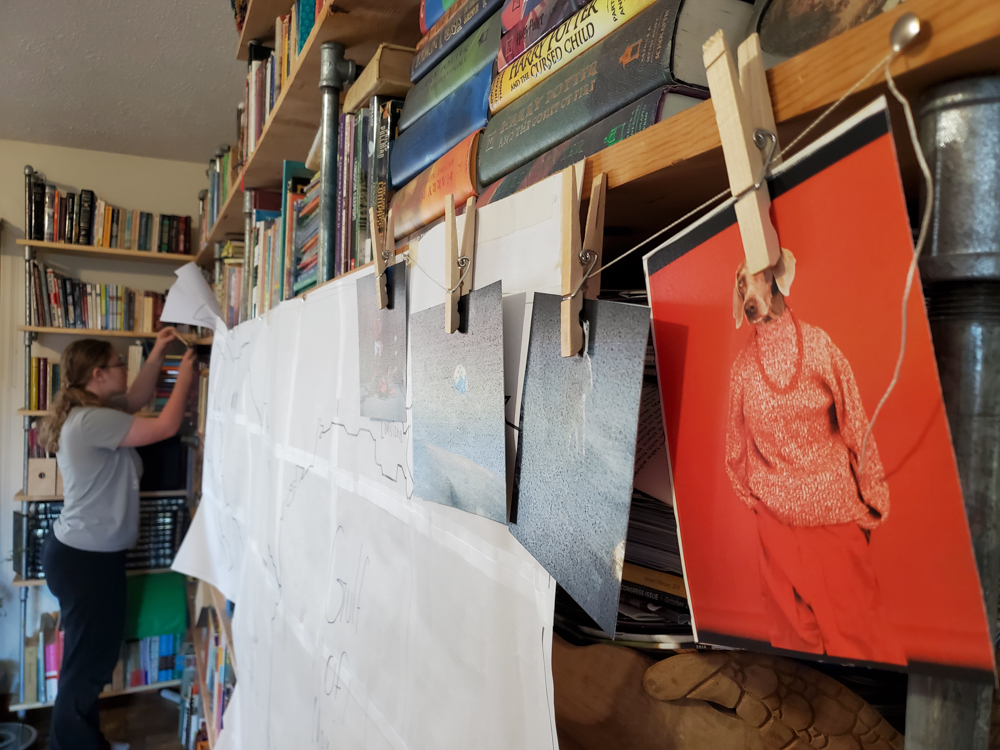You might remember that Syd has a passion for fashion design, yes?
She and I are especially happy that now she's homeschooling again, she's once again got plenty of time to dive into all these big passions of hers. Along with her academic work and her everyday art projects, I've been encouraging her to design and make some bigger, more ambitious art projects. The planning and troubleshooting are great skills to practice, and the projects, themselves, are always sources of inspiration for Syd to teach herself something new. The four-foot-tall acrylic painting on canvas that now hangs in our front hall taught Syd not just a billion more things to know about acrylic painting, but also got us discussing and making decisions about how artists obtain and use reference images, and what's acceptable professionally versus academically.
So when Syd started thinking about planning her next Trashion/Refashion Show design, I started thinking about ways to make the project even more open-ended for her. We decided that one good way to help her elevate the sophistication of her designs is to make her a custom dress form.
And what should we make this custom dress form out of?
DUCT TAPE!!!!!
We used this Etsy Labs tutorial as our spine, but I got the expanding foam idea from this tutorial.
I bought this set of duct tape way back when the kids and I were making duct tape wallets and I wanted them to have a lot of color options:
Five years later, I still have some remnants of the least popular colors from that set left. I've been using them whenever I need duct tape, of course, but this project used up every single last little bit, and I'm pretty thrilled to 1) have had just the random supply that I needed when I needed it, and 2) have all those rolls of duct tape GONE!
Syd put on a baggy old T-shirt, and we had a hilarious time wrapping her in tape. That morning was definitely a contrast in homeschooled kids--Will, hard at work on her calculus homework, and Syd, hard at work on being mummy-wrapped in tape.
Side note: personally, I find the calculus easier to mentor. Will's kind of homeschool work is easy for me to identify as "proper" work, and I have really been struggling to find my legs homeschooling an art kid whose schoolwork looks so different. She's over there bopping along, listening to a podcast and drawing in her sketchbook, working hard on improving her draftsmanship or whatever, and I'm over here trying equally hard not to nag her about reading the rest of her biology chapter, or working on her poetry essay. Anyway...
After we finished wrapping the kid in duct tape, I cut it off her and we taped it back together and stuffed it full of newspaper and expanding foam.
- Buy the kind that says minimal expanding, or it'll expand so much that it will warp the dress form.
- Resign yourself to using the entire can at once. I used half a can, then cleaned it off according to the directions and set it aside. But when I came back to it, I couldn't for the life of me get it going again! I had to go buy another can, and they're not the cheapest thing at Menard's. This time, though, when I got through half a can and felt like the dress form was done, I handed the rest of the can off to Matt and was all, "Pretty please go wander around outside and fill in cracks and stuff." I think the chicken coop will be insulated exceptionally well this winter!
- Do NOT be this kind of fool:
That wider PVC pipe goes through the dress form and is adhered inside with expanding foam, so it can't be removed. The narrow PVC pipe fits inside that wider one, and over the metal rod of the stand, so it can be removed if Syd wants to work with the dress form on a table top. But Matt also cut it so that when you put it on the floor stand, it exactly matches Syd's height!
















































